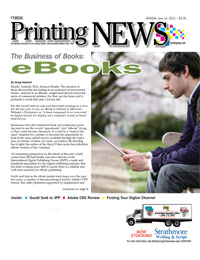|
  June 14, 2010— Adobe recently released the latest version of its products—Creative Suite 5. In it, there are new versions of all the products, with some major new features to be excited about. For the purposes of this review, we'll be focusing on the two programs printers need and use most often: Photoshop and InDesign.
June 14, 2010— Adobe recently released the latest version of its products—Creative Suite 5. In it, there are new versions of all the products, with some major new features to be excited about. For the purposes of this review, we'll be focusing on the two programs printers need and use most often: Photoshop and InDesign.
Photoshop's New Features
One of the most talked about, and potentially most useful, new tool in Photoshop CS5 is Content-Aware Fill. It allows users to select an element in a photograph, and have Photoshop remove it, automatically filling in the space by using what's around the hole to create a seamless image.
There are two ways to use this tool: as an option in the Spot Healing Brush, or as part of the Fill menu. With Spot Healing, users can fix anomalies and small problems in images much faster and easier, making for a huge jump in productivity. With the Fill options, images can be changed more drastically, in less time that it would have taken previously, again meaning designers can move on to other projects and tasks. In practice, using the tool, especially as part of the Fill dialogue, takes some getting used to. In our tests, without careful selections, there were instances where part of what we were trying to get rid of ended up in odd places in the photo, as Content Aware tried to figure out what we wanted. But after some practice with the tool we had fantastic results. Another feature that can make creatives more productive is HDR Toning. This allows users to play with the exposure and toning of an image to get the perfect balance, or, if they are so inclined, to take it to a more creative place, such as experimenting with overexposure, etc.
Another potential time-saver for those who are constantly finding themselves adjusting the tonal ranges in images, HDR Toning gives users more options that are easier to use and more powerful than what was available in previous versions. Puppet Warp is one of those features that, if it's something you need, can prove to be an extreme time saver. It allows users to add "joints" to elements of an image and move them around, maintaining the ratios and proportions of the original items. The example Adobe used in its materials, that of an elephant, demonstrates this feature effectively, making a straight trunk into a curved one seamlessly and almost effortlessly. A great tool for designers and shops alike who need to tweak images for the highest impact.
A Few InDesign Upgrades
There are quite a few new features in InDesign CS5 that printers and designers can use to their advantage. Here are a few that really caught our eye as we played around with the new program. First, and most exciting to this editor, was the ability to span columns with a few clicks. There is nothing more frustrating than having a layout change and having to manually reflow all the copy. Or trying to put in a caption or box that spans across multiple columns. Or, for that matter, trying to put together a list that fits in the column, but has multiple columns in and of itself.
InDesign has made all of these much easier to deal with. Span Columns allows users to select the copy they want to change, and then pull up a context menu where they can choose to span two, three, four or more columns, based on their needs. It's a matter of a few clicks, and it's done, instead of having to create and position boxes, reflow text, rearrange the layout, etc.
Split Columns takes the selected text and automatically puts it into as many columns as you prefer, while staying within the confines of master column. Again, within the space of a few clicks, something that used to take a fair amount of time and effort to get just right is done automatically and perfectly. Talk about a time saver!
Another big feature upgrade in InDesign is in the Layers panel. Users can now group layers and elements together. Like in other products, each element is now a separate item in the panel, allowing users to change and work on either a single piece, or a group of items, based on what they need. The new panel also allows users to select multiple objects and change them at the same time—such as resizing—without having to group them. Just make the selection and then start changing. This makes it much easier to go in and make exactly the changes that are needed without having to spend a large amount of time adjusting each element individually.
Finally, the last tool we'll talk about in this review is the new placement features. Adobe has been steadily increasing the functionality and ease of use of placing objects and images into layouts over the last several releases, and this one is no different. They company has made it easy, with a few mouse clicks, to create placeholder grids for images, text or any other element that needs to go on the page. While dragging a Rectangle Frame to fill a space, users can use the arrow keys to add rows and columns for perfectly spaced content. But what if you don't want each element to be exactly the same size in the grid? The new Gap tool takes care of that, allowing users to go in and adjust each space in the grid individually, creating a custom layout much more quickly than was possible in the past.
These are just a few of the features in Photoshop and InDesign that will mean huge leaps in productivity and creativity for printers. Where CS4 was more of an incremental upgrade, with mostly improvements to existing tools, CS5 has a host of new features and major upgrades. If you've been holding out on upgrading to CS4, this is the product you were waiting for. With one investment, you can increase the productivity of your shop by leaps and bounds.
|


